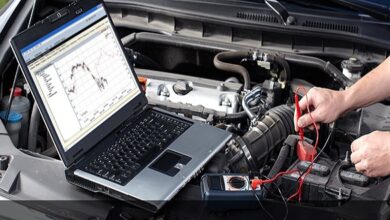
Limits of the conventional wiring system
The complexity of modern wiring systems has been increasing steadily over the last 25 years or so and, in recent years, has increased dramatically. It has now reached a point where the size and weight of the wiring harness is a major problem. The number of separate wires required on a top-of-the-range vehicle can be in the region of 1500! The wiring loom required to control all functions in or from the driver’s door can require up to 50 wires, the systems in the dashboard area alone can use over 100 wires and connections.
Taking this idea a stage further, if data could be transmitted along one wire and made available to all parts of the vehicle, then the vehicle wiring could be reduced to just three wires. These wires would be a mains supply, an earth connection and a signal wire. The idea of using just one line for many signals is not new and has been in use in areas such as telecommunications for many years.
Bosch CAN (Controller Area Networks)
Bosch has developed the protocol known as ‘CAN’ or Controller Area Network. This system is claimed to meet practically all requirements with a very small chip surface (easy to manufacture, therefore cheaper). CAN is suitable for transmitting data in the area of drive line components, chassis components and mobile communications.
Multiplex data bus
In order to transmit different data on one line, a number of criteria must be carefully defined and agreed. This is known as the communications protocol. Some of the variables that must be defined are as follows:
- Method of addressing.
- Transmission sequence.
- Control signals.
- Error detection.
- Error treatment.
- Speed or rate of transmission.
Many sensors and actuators are not yet ‘buyable’ and, although prototype vehicles have been produced, the conventional wiring cannot completely be replaced. The electronic interface units must be placed near, or ideally integrated into, sensors and actuators. Particularly in the case of engine type sensors and actuators due to heat and vibration, this will require further development to ensure reliability and low price.
CAN signal format
The CAN message signal consists of a sequence of binary digits (bits). A voltage (or light in fiber optics) being present indicates the value ‘1’ while none present indicates ‘0’. The actual message can vary between 44 and 108 bits in length. This is made up of a start bit, name, control bits, the data itself, a cyclic redundancy check (CRC) for error detection, a confirmation signal and finally a number of stop bits.
Local intelligence
A decision has to be made on a vehicle as to where the ‘intelligence’ will be located. The first solution is to use a local module, which will drive the whole of a particular sub-system. It is connected by means of conventional wires. This solves the problem of the number of wires running from the vehicle body to the door but still involves a lot of wiring and connectors in the door. This can reduce reliability.
Fiber optics for multiplex data bus
‘Fabre optics’ is the technique of using thin glass or plastic fibers that transmit light throughout their length by internal reflections. The advantage of fiber optics for use as a data bus is their resistance to interference from electromagnetic radiation (EMR) or interference. It is also possible to send a considerable amount of data at very high speed. This is why fiber-optic technology is in common use for telecommunication systems.
The need for multiplexing
As an example of how the need for multiplexed systems is increasing, look at Figure 4.28. This figure shows the block diagram for an intelligent lighting system, but note how many sensor inputs are required. Much of this data would already be available on a data bus. This issue is one of the main reasons for the development of multiplexed systems.
Summary
CAN is a shared broadcast bus that runs at speeds up to 1 Mbit/s. It is based around sending messages (or frames), which are of variable length, between 0 and 8 bytes. Each frame has an identifier, which must be unique (i.e. two nodes on the same bus must not send frames with the same identifier). The interface between the CAN bus and the CPU is usually called the CAN controller.




